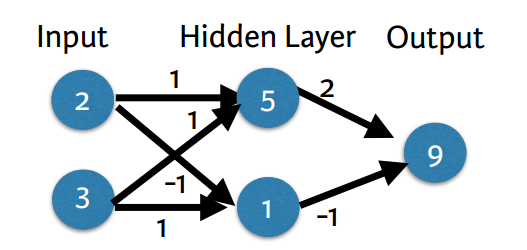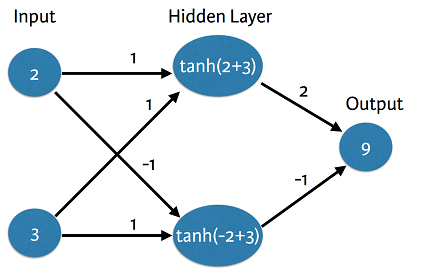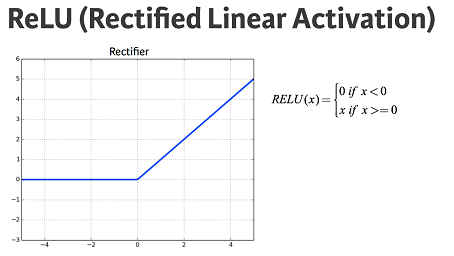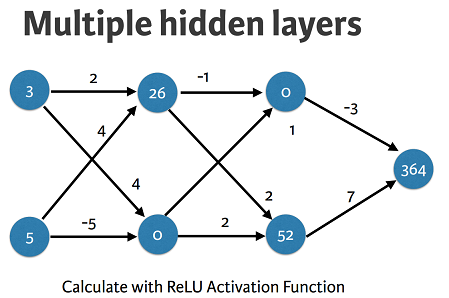Introduction to Deep Learning
01 Basics
https://jiayiwangjw.github.io/2017/10/03/Introduction-to-Deep-Learning-01/#02-opitimization
Coding the forward propagation algorithm
In this exercise, you'll
write code to do forward propagation (prediction) for your first neural
network:
Each data point is a
customer. The first input is how many accounts they have, and the second input
is how many children they have. The model will predict how many transactions
the user makes in the next year. You will use this data throughout the first 2
chapters of this course.
The input data has been
pre-loaded as input_data, and the weights are available in a dictionary called weights. The array
of weights for the first node in the hidden layer are in weights['node_0'], and the array of weights for the second node in the hidden layer are
in weights['node_1'].
The weights feeding into the
output node are available in weights['output'].
NumPy will be pre-imported
for you as np in all exercises.
Instructions
100 XP
- Calculate the value in node 0 by
multiplying input_data by its weights weights['node_0'] and computing
their sum. This
is the 1st node in the hidden layer.
- Calculate the value in node 1
using input_data and weights['node_1']. This is the 2nd node in the
hidden layer.
- Put the hidden layer values into an
array. This has been done for you.
- Generate the prediction by
multiplying hidden_layer_outputsby weights['output'] and computing
their sum.
- Hit 'Submit Answer' to print the
output!
Take Hint (-30 XP)
1.-
CODIGOS PROBADOS, 1forprop.py in deeplearning folder desktop 010109
import numpy as np
input_data = np.array([2,3])
weights = {'node_0': np.array([1,1]),
'node_1': np.array([-1,1]),
'output': np.array([2,-1])}
node_0_value = (input_data * weights['node_0']).sum()
node_1_value = (input_data * weights['node_1']).sum()
hidden_layer_values = np.array([node_0_value, node_1_value])
print(hidden_layer_values)
output = (hidden_layer_values * weights['output']).sum()
print(output)
salida
C:\>python 1forprop.py
[5 1]
9
2.- Activation functions
An “activation function” is a function applied at each node. It converts the node’s input into some output.

CODIGOS PROBADOS, 2activatanh.py in deeplearning folder desktop 010109
import numpy as np
input_data = np.array([2,3])
weights = {'node_0': np.array([1,1]),
'node_1': np.array([-1,1]),
'output': np.array([2,-1])}
node_0_input = (input_data * weights['node_0']).sum()
node_0_output = np.tanh(node_0_input)
node_1_input = (input_data * weights['node_1']).sum()
node_1_output = np.tanh(node_1_input)
hidden_layer_values = np.array([node_0_output, node_1_output])
print(hidden_layer_values)
output = (hidden_layer_values * weights['output']).sum()
print(output)
input_data = np.array([2,3])
weights = {'node_0': np.array([1,1]),
'node_1': np.array([-1,1]),
'output': np.array([2,-1])}
node_0_input = (input_data * weights['node_0']).sum()
node_0_output = np.tanh(node_0_input)
node_1_input = (input_data * weights['node_1']).sum()
node_1_output = np.tanh(node_1_input)
hidden_layer_values = np.array([node_0_output, node_1_output])
print(hidden_layer_values)
output = (hidden_layer_values * weights['output']).sum()
print(output)
salida
C:\>python 2activatanh.py
[0.9999092 0.76159416]
1.2382242525694254
3.-

The Rectified Linear Activation Function
As Dan
explained to you in the video, an "activation function" is a function
applied at each node. It converts the node's input into some output.
The rectified
linear activation function (called ReLU) has been shown to lead to
very high-performance networks. This function takes a single number as an
input, returning 0 if the input is negative, and the input if the input is
positive.
Here are some
examples:
relu(3) = 3
relu(-3) = 0
relu(3) = 3
relu(-3) = 0
Instructions
100 XP
- Fill in the definition of the relu() function:
- Use the max() function to calculate the value
for the output of relu().
- Apply the relu() function to node_0_input to
calculate node_0_output.
- Apply the relu() function to node_1_input to
calculate node_1_output.
The rectified linear activation function (called ReLU) has been shown to lead to very high-performance networks. This function takes a single number as an input, returning 0 if the input is negative, and the input if the input is positive.
Rectifier (neural networks)
In the context of artificial neural networks, the rectifier is an activation function defined as the positive part of its argument:
,
where x is the input to a neuron. This is also known as a ramp function and is analogous to half-wave rectification in electrical engineering. This activation function was first introduced to a dynamical network by Hahnloser et al. in 2000 with strong biological motivations and mathematical justifications.[1][2] It has been demonstrated for the first time in 2011 to enable better training of deeper networks,[3] compared to the widely-used activation functions prior to 2011, e.g., the logistic sigmoid (which is inspired by probability theory; see logistic regression) and its more practical[4] counterpart, the hyperbolic tangent. The rectifier is, as of 2018, the most popular activation function for deep neural networks.[5][6]
def relu(input):
'''Define your relu activation function here'''
# Calculate the value for the output of the relu function: output
output = max(input, 0)
# Return the value just calculated
return(output)
import numpy as np
input_data = np.array([-1,2])
weights = {'node_0': np.array([3,3]),
'node_1': np.array([1,5]),
'output': np.array([2,-1])}
node_0_input = (input_data * weights['node_0']).sum()
node_0_output = relu(node_0_input)
node_1_input = (input_data * weights['node_1']).sum()
node_1_output = relu(node_1_input)
hidden_layer_values = np.array([node_0_output, node_1_output])
print(hidden_layer_values)
output = (hidden_layer_values * weights['output']).sum()
print(output)
'''Define your relu activation function here'''
# Calculate the value for the output of the relu function: output
output = max(input, 0)
# Return the value just calculated
return(output)
import numpy as np
input_data = np.array([-1,2])
weights = {'node_0': np.array([3,3]),
'node_1': np.array([1,5]),
'output': np.array([2,-1])}
node_0_input = (input_data * weights['node_0']).sum()
node_0_output = relu(node_0_input)
node_1_input = (input_data * weights['node_1']).sum()
node_1_output = relu(node_1_input)
hidden_layer_values = np.array([node_0_output, node_1_output])
print(hidden_layer_values)
output = (hidden_layer_values * weights['output']).sum()
print(output)
Salida
C:\>python relu.py
[3 9]
-3
C:\>
4.- Applying the network to many observations/rows of data
Define a function called predict_with_network() which will generate predictions for multiple data observations
You'll now define a function called
predict_with_network()which will generate predictions for multiple data
observations, which are pre-loaded as input_data. As before, weights are also pre-loaded. In addition, the relu() function you defined in the previous exercise has been pre-loaded.
Instructions
0 XP
- Define
a function called
predict_with_network()that accepts two arguments -input_data_rowandweights- and returns a prediction from the network as the output. - Calculate
the input and output values for each node, storing them as:
node_0_input,node_0_output,node_1_input, andnode_1_output. - To
calculate the input value of a node, multiply the relevant arrays
together and compute their sum.
- To
calculate the output value of a node, apply the
relu()function to the input value of the node. - Calculate
the model output by calculating
input_to_final_layerandmodel_outputin the same ay you calculated the input and output values for the nodes. - Use
a
forloop to iterate overinput_data: - Use
your
predict_with_network()to generate predictions for each row of theinput_data-input_data_row. Append each prediction toresults.
Hint
·
To calculate the input value for each node, multiply
the two relevant arrays and compute their sum. For example, the two relevant
arrays for calculating
node_0_input are input_data_row and weights['node_0'].
· To compute the output
value of each node, apply the
relu()function to the input
value.
· Inside the
for loop, use
the predict_with_network()function with each row of the
input data - input_data_row - and weights as the
arguments.
Did
you find this hint helpful?
def relu(input):
'''Define your relu activation function here'''
# Calculate the value for the output of the relu function: output
output = max(input, 0)
# Return the value just calculated
return(output)
import numpy as np
input_data = np.array([-1,2])
weights = {'node_0': np.array([3,3]),
'node_1': np.array([1,5]),
'output': np.array([2,-1])}
node_0_input = (input_data * weights['node_0']).sum()
node_0_output = relu(node_0_input)
node_1_input = (input_data * weights['node_1']).sum()
node_1_output = relu(node_1_input)
hidden_layer_values = np.array([node_0_output, node_1_output])
print(hidden_layer_values)
output = (hidden_layer_values * weights['output']).sum()
print(output)
input_data = np.array([[3,5],[2,-1],[0,0],[8,4]])
input_data
def predict_with_network(input_data_row, weights):
# Calculate node 0 value. To calculate the input value of a node, multiply the relevant
# arrays together and compute their sum
node_0_input = (input_data_row * weights['node_0']).sum()
node_0_output = relu(node_0_input)
# Calculate node 1 value
node_1_input = (input_data_row * weights['node_1']).sum()
node_1_output = relu(node_1_input)
# Put node values into array: hidden_layer_outputs
hidden_layer_outputs = np.array([node_0_output, node_1_output])
# Calculate model output
input_to_final_layer = (hidden_layer_outputs * weights['output']).sum()
model_output = relu(input_to_final_layer)
# Return model output
return(model_output)
# Create empty list to store prediction results
results = []
for input_data_row in input_data:
# Append prediction to results
results.append(predict_with_network(input_data_row, weights))
# Print results
print(results)
SALIDA
C:\>python 4relumultiple.py
[3 9]
-3
[20, 6, 0, 44]
import numpy as np
def relu(input):
'''Define your relu activation function here'''
# Calculate the value for the output of the relu function: output
output = max(input, 0)
# Return the value just calculated
return(output)
def predict_with_network(input_data_row, weights):
# Calculate node 0 value. To calculate the input value of a node, multiply the relevant
# arrays together and compute their sum
node_0_input = (input_data_row * weights['node_0']).sum()
node_0_output = relu(node_0_input)
# Calculate node 1 value
node_1_input = (input_data_row * weights['node_1']).sum()
node_1_output = relu(node_1_input)
# Put node values into array: hidden_layer_outputs
hidden_layer_outputs = np.array([node_0_output, node_1_output])
# Calculate model output
input_to_final_layer = (hidden_layer_outputs * weights['output']).sum()
model_output = relu(input_to_final_layer)
# Return model output
return(model_output)
input_data = np.array([3,5])
weights = {'node_0_0': np.array([2,4]),
'node_0_1': np.array([4,-5]),
'node_1_0': np.array([-1,1]),
'node_1_1': np.array([2,2]),
'output': np.array([-3,7])}
def predict_with_network2(input_data):
# Calculate node 0 in the first hidden layer
node_0_0_input = (input_data * weights['node_0_0']).sum()
node_0_0_output = relu(node_0_0_input)
# Calculate node 1 in the first hidden layer
node_0_1_input = (input_data * weights['node_0_1']).sum()
node_0_1_output = relu(node_0_1_input)
# Put node values into array: hidden_0_outputs
hidden_0_outputs = np.array([node_0_0_output, node_0_1_output])
print(hidden_0_outputs)
# Calculate node 0 in the second hidden layer
node_1_0_input = (hidden_0_outputs * weights['node_1_0']).sum()
node_1_0_output = relu(node_1_0_input)
# Calculate node 1 in the second hidden layer
node_1_1_input = (hidden_0_outputs * weights['node_1_1']).sum()
node_1_1_output = relu(node_1_1_input)
# Put node values into array: hidden_1_outputs
hidden_1_outputs = np.array([node_1_0_output, node_1_1_output])
print(hidden_1_outputs)
# Calculate model output: model_output
model_output = (hidden_1_outputs * weights['output']).sum()
# Return model_output
return(model_output)
output = predict_with_network2(input_data)
print(output)
SALIDA
C:\>python 5multiplelayers.py
[26 0]
[ 0 52]
364
02 Opitimization
6.- Coding how weight changes affect accuracy
Now you'll get to change weights in a real network and see how they affect model accuracy!
Have a look at the following neural network:

Its weights have been pre-loaded as
weights_0. Your task in this exercise is to update a single weight in weights_0 to create weights_1, which gives a perfect prediction (in which the predicted value is equal to target_actual: 3).
Use a pen and paper if necessary to experiment with different combinations. You'll use the
predict_with_network() function, which takes an array of data as the first argument, and weights as the second argument.- Create a dictionary of weights called
weights_1where you have changed 1 weight fromweights_0(You only need to make 1 edit toweights_0to generate the perfect prediction). - Obtain predictions with the new weights using the
predict_with_network()function withinput_dataandweights_1. - Calculate the error for the new weights by subtracting
target_actualfrommodel_output_1. - Hit 'Submit Answer' to see how the errors compare!
import numpy as np
def relu(input):
'''Define your relu activation function here'''
# Calculate the value for the output of the relu function: output
output = max(input, 0)
# Return the value just calculated
return(output)
def predict_with_network(input_data_row, weights):
# Calculate node 0 value. To calculate the input value of a node, multiply the relevant
# arrays together and compute their sum
node_0_input = (input_data_row * weights['node_0']).sum()
node_0_output = relu(node_0_input)
# Calculate node 1 value
node_1_input = (input_data_row * weights['node_1']).sum()
node_1_output = relu(node_1_input)
# Put node values into array: hidden_layer_outputs
hidden_layer_outputs = np.array([node_0_output, node_1_output])
# Calculate model output
input_to_final_layer = (hidden_layer_outputs * weights['output']).sum()
model_output = relu(input_to_final_layer)
# Return model output
return(model_output)
input_data = np.array([0,3])
# Sample weights
weights_0 = {'node_0': [2, 1],
'node_1': [1, 2],
'output': [1, 1]
}
# The actual target value, used to calculate the error
target_actual = 3
# Make prediction using original weights, this was defined previously
predict_with_network(input_data, weights_0)
model_output_0 = predict_with_network(input_data, weights_0)
# Calculate error: error_0
error_0 = model_output_0 - target_actual
# Create weights that cause the network to make perfect prediction (3): weights_1
weights_1 = {'node_0': [2, 1],
'node_1': [1, 0], #change only one weight to ensure 0 error
'output': [1, 1]
}
# Make prediction using new weights: model_output_1
model_output_1 = predict_with_network(input_data, weights_1)
# Calculate error: error_1
error_1 = model_output_1 - target_actual
# Print error_0 and error_1
print(error_0)
print(error_1)
C:\>python 6optimization.py
6
0
7.- Scaling up to multiple data points
PODEMOS CALCULAR EL ERROR EN BASES A MODELOS CON DOS DISTINTAS MATRICES DE PESOS
You've seen how different weights will have different accuracies on a single prediction. But usually, you'll want to measure model accuracy on many points. You'll now write code to compare model accuracies for two different sets of weights, which have been stored as
weights_0 and weights_1.input_data is a list of arrays. Each item in that list contains the data to make a single prediction. target_actuals is a list of numbers. Each item in that list is the actual value we are trying to predict.
In this exercise, you'll use the
mean_squared_error() function from sklearn.metrics. It takes the true values and the predicted values as arguments.
You'll also use the preloaded
predict_with_network() function, which takes an array of data as the first argument, and weights as the second argument.- Import
mean_squared_errorfromsklearn.metrics. - Using a
forloop to iterate over each row ofinput_data:- Make predictions for each row with
weights_0using thepredict_with_network()function and append it tomodel_output_0. - Do the same for
weights_1, appending the predictions tomodel_output_1.
- Make predictions for each row with
- Calculate the mean squared error of
model_output_0and thenmodel_output_1using themean_squared_error()function. The first argument should be the actual values (target_actuals), and the second argument should be the predicted values (model_output_0ormodel_output_1).
import numpy as np
from sklearn.metrics import mean_squared_error
def relu(input):
'''Define your relu activation function here'''
# Calculate the value for the output of the relu function: output
output = max(input, 0)
# Return the value just calculated
return(output)
def predict_with_network(input_data_row, weights):
# Calculate node 0 value. To calculate the input value of a node, multiply the relevant
# arrays together and compute their sum
node_0_input = (input_data_row * weights['node_0']).sum()
node_0_output = relu(node_0_input)
# Calculate node 1 value
node_1_input = (input_data_row * weights['node_1']).sum()
node_1_output = relu(node_1_input)
# Put node values into array: hidden_layer_outputs
hidden_layer_outputs = np.array([node_0_output, node_1_output])
# Calculate model output
input_to_final_layer = (hidden_layer_outputs * weights['output']).sum()
model_output = relu(input_to_final_layer)
# Return model output
return(model_output)
# The data point you will make a prediction for
input_data = np.array(([0, 3],[1,2],[-1,-2],[4,0]))
# Sample weights
weights_0 = {'node_0': [2, 1],
'node_1': [1, 2],
'output': [1, 1]
}
weights_1 = {'node_0': [2, 1],
'node_1': [1., 1.5],
'output': [1., 1.5]
}
#target_actuals = np.array([1,3,5,7])
target_actuals = ([1,3,5,7])
target_actuals
# Create model_output_0
model_output_0 = []
# Create model_output_0
model_output_1 = []
# Loop over input_data
for row in input_data:
# Append prediction to model_output_0
model_output_0.append(predict_with_network(row, weights_0))
# Append prediction to model_output_1
model_output_1.append(predict_with_network(row, weights_1))
# Calculate the mean squared error for model_output_0: mse_0
mse_0 = mean_squared_error(target_actuals, model_output_0)
# Calculate the mean squared error for model_output_1: mse_1
mse_1 = mean_squared_error(target_actuals, model_output_1)
# Print mse_0 and mse_1
print("Mean squared error with weights_0: %f" %mse_0)
print("Mean squared error with weights_1: %f" %mse_1)
C:\>python 7optimization.py
Mean squared error with weights_0: 37.500000
Mean squared error with weights_1: 49.890625
from sklearn.metrics import mean_squared_error
def relu(input):
'''Define your relu activation function here'''
# Calculate the value for the output of the relu function: output
output = max(input, 0)
# Return the value just calculated
return(output)
def predict_with_network(input_data_row, weights):
# Calculate node 0 value. To calculate the input value of a node, multiply the relevant
# arrays together and compute their sum
node_0_input = (input_data_row * weights['node_0']).sum()
node_0_output = relu(node_0_input)
# Calculate node 1 value
node_1_input = (input_data_row * weights['node_1']).sum()
node_1_output = relu(node_1_input)
# Put node values into array: hidden_layer_outputs
hidden_layer_outputs = np.array([node_0_output, node_1_output])
# Calculate model output
input_to_final_layer = (hidden_layer_outputs * weights['output']).sum()
model_output = relu(input_to_final_layer)
# Return model output
return(model_output)
# The data point you will make a prediction for
input_data = np.array(([0, 3],[1,2],[-1,-2],[4,0]))
# Sample weights
weights_0 = {'node_0': [2, 1],
'node_1': [1, 2],
'output': [1, 1]
}
weights_1 = {'node_0': [2, 1],
'node_1': [1., 1.5],
'output': [1., 1.5]
}
#target_actuals = np.array([1,3,5,7])
target_actuals = ([1,3,5,7])
target_actuals
# Create model_output_0
model_output_0 = []
# Create model_output_0
model_output_1 = []
# Loop over input_data
for row in input_data:
# Append prediction to model_output_0
model_output_0.append(predict_with_network(row, weights_0))
# Append prediction to model_output_1
model_output_1.append(predict_with_network(row, weights_1))
# Calculate the mean squared error for model_output_0: mse_0
mse_0 = mean_squared_error(target_actuals, model_output_0)
# Calculate the mean squared error for model_output_1: mse_1
mse_1 = mean_squared_error(target_actuals, model_output_1)
# Print mse_0 and mse_1
print("Mean squared error with weights_0: %f" %mse_0)
print("Mean squared error with weights_1: %f" %mse_1)
C:\>python 7optimization.py
Mean squared error with weights_0: 37.500000
Mean squared error with weights_1: 49.890625
Gradient descent
When plotting the mean-squared error loss function against predictions, the slope is \begin{equation} 2 \times X \times (Y-Xb) \end{equation} \begin{equation} 2 \times InputData \times Error. \end{equation}
Note that X and B may have multiple numbers (X is a vector for each data point, and B is a vector). In this case, the output will also be a vector, which is exactly what you want.
Calculating slopes
You're now going to practice calculating slopes. When plotting the mean-squared error loss function against predictions, the slope is
2 * x * (y-xb), or 2 * input_data * error. Note that x and bmay have multiple numbers (x is a vector for each data point, and b is a vector). In this case, the output will also be a vector, which is exactly what you want.
You're ready to write the code to calculate this slope while using a single data point. You'll use pre-defined weights called
weights as well as data for a single point called input_data. The actual value of the target you want to predict is stored in target.- Calculate the predictions,
preds, by multiplyingweightsby theinput_dataand computing their sum. - Calculate the error, which is
targetminuspreds. Notice that this error corresponds toy-xbin the gradient expression. - Calculate the slope of the loss function with respect to the prediction. To do this, you need to take the product of
input_dataanderrorand multiply that by2.
import numpy as np
weights = np.array([0,2,1])
input_data = np.array([1,2,3])
target = 0
# Calculate the predictions: preds
preds = (weights * input_data).sum()
# Calculate the error: error (Notice that this error corresponds to y-xb in the gradient expression.)
error = preds - target
# Calculate the slope of the loss function with respect to the prediction.
slope = 2 * input_data * error
# Print the slope
print(slope)
C:\>python gradient_calcule_slopes.py
[14 28 42]
C:\>
Improving model weights
Hurray! You've just calculated the slopes you need. Now it's time to use those slopes to improve your model. If you add the slopes to your weights, you will move in the right direction. However, it's possible to move too far in that direction. So you will want to take a small step in that direction first, using a lower learning rate, and verify that the model is improving.
The weights have been pre-loaded as
weights, the actual value of the target as target, and the input data as input_data. The predictions from the initial weights are stored as preds.- Set the learning rate to be
0.01and calculate the error from the original predictions. This has been done for you. - Calculate the updated weights by subtracting the product of
learning_rateandslopefromweights. - Calculate the updated predictions by multiplying
weights_updatedwithinput_dataand computing their sum. - Calculate the error for the new predictions. Store the result as
error_updated. - Hit 'Submit Answer' to compare the updated error to the original!
# Set the learning rate: learning_rate
learning_rate = 0.01
# Calculate the predictions: preds
preds = (weights * input_data).sum()
# Calculate the error: error
error = preds - target
# Calculate the slope: slope
slope = 2 * input_data * error
# Update the weights: weights_updated
weights_updated = weights-learning_rate*slope
# Get updated predictions: preds_updated
preds_updated = (weights_updated*input_data).sum()
# Calculate updated error: error_updated
error_updated = preds_updated-target
CORRECTO
import numpy as np
weights = np.array([0,2,1])
input_data = np.array([1,2,3])
target = 0
# Calculate the predictions: preds
preds = (weights * input_data).sum()
# Calculate the error: error (Notice that this error corresponds to y-xb in the gradient expression.)
error = preds - target
# Calculate the slope of the loss function with respect to the prediction.
slope = 2 * input_data * error
# Print the slope
print(slope)
# Set the learning rate: learning_rate
learning_rate = 0.01
# Update the weights: weights_updated
weights_updated = weights - learning_rate * slope
# Get updated predictions: preds_updated
preds_updated = (weights_updated * input_data).sum()
# Calculate updated error: error_updated
error_updated = preds_updated - target
# Print the original error
print(error)
# Print the updated error
print(error_updated)
C:\>python gradient_calcule_slopes.py
[14 28 42]
7
5.04
DISMINUYE EL ERROR
Making multiple updates to weights
You're now going to make multiple updates so you can dramatically improve your model weights, and see how the predictions improve with each update.
To keep your code clean, there is a pre-loaded
get_slope() function that takes input_data, target, and weights as arguments. There is also a get_mse() function that takes the same arguments. The input_data, target, and weights have been pre-loaded.
This network does not have any hidden layers, and it goes directly from the input (with 3 nodes) to an output node. Note that
weights is a single array.
We have also pre-loaded
matplotlib.pyplot, and the error history will be plotted after you have done your gradient descent steps.- Using a
forloop to iteratively update weights:- Calculate the slope using the
get_slope()function. - Update the weights using a learning rate of
0.01. - Calculate the mean squared error (
mse) with the updated weights using theget_mse()function. - Append
msetomse_hist.
- Calculate the slope using the
- Hit 'Submit Answer' to visualize
mse_hist. What trend do you notice?
from sklearn.metrics import mean_squared_error
import numpy as np
import matplotlib.pyplot as plt
def pred(input_data, target, weights):
return ((input_data * weights).sum())
def get_slope(input_data, target, weights):
preds = pred(input_data, target, weights)
error = target - preds
slope = 2 * input_data * error
return slope
def get_mse(input_data, target, weights):
preds = pred(input_data, target, weights)
return mean_squared_error([preds], [target])
weights = np.array([0, 2, 1])
input_data = np.array([1, 2, 3])
target = 0
learning_rate = 0.01
n_updates = 20
mse_hist = []
for i in range(n_updates):
slope = get_slope(input_data, target, weights)
weights = weights + (learning_rate * slope)
mse = get_mse(input_data, target, weights)
mse_hist.append(mse)
plt.plot(mse_hist)
plt.xlabel('Iterations')
plt.ylabel('Mean Squared Error')
plt.show()
SALIDA
https://github.com/neelabhpant/Deep-Learning-in-Python/blob/master/Gradient_Descent.py



































Thanks for sharing.
ResponderEliminar